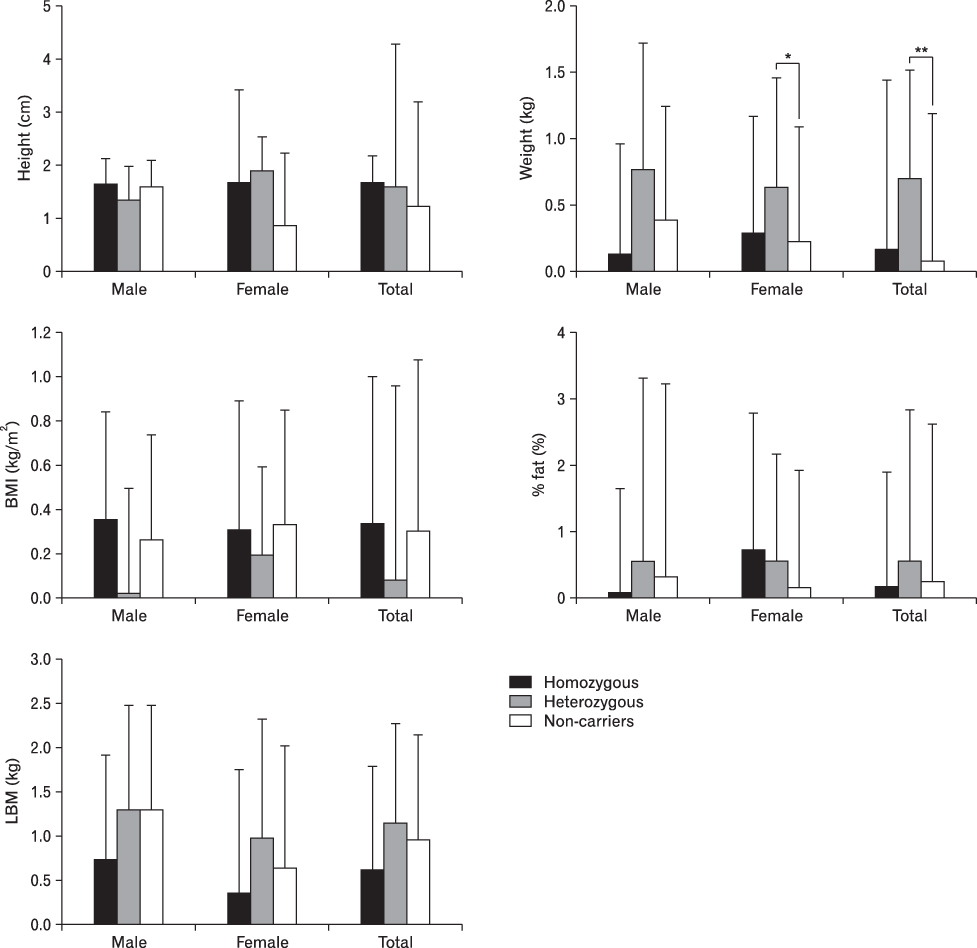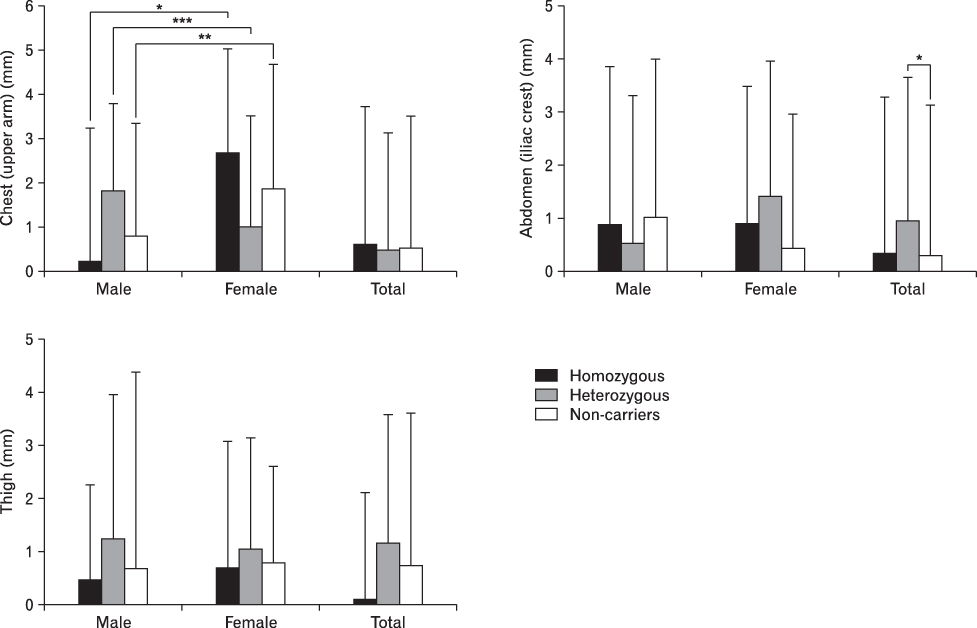Korean J Sports Med.
2012 Jun;30(1):55-64. 10.5763/kjsm.2012.30.1.55.
Association of IGF-I Gene Polymorphism with Blood Concentration of IGF-I, Body Composition, Bone Age and Response to Combined Exercise Program in Teen-Aged Children
- Affiliations
-
- 1Department of Physical Education, Keimyung University, Daegu, Korea. kjk744@kmu.ac.kr
- KMID: 2288649
- DOI: http://doi.org/10.5763/kjsm.2012.30.1.55
Abstract
- Association of insulin like growth factor (IGF)-I gene polymorphism with blood concentration of IGF-I, body composition, bone age and response to combined exercise program in teen-aged children. The purpose of this study was to determine whether there are the differences of blood concentration of IGF-I, body composition, bone age and response to combined exercise program according to IGF-I gene polymorphism in Korean teen-aged children. Subjects were recruited by 143 teen-aged children (male: 78, female: 65) from elementary school. Twelve weeks exercise program was consisted of resistance training and aerobic exercise. For the comparison of items and responses to combined exercise program according to IGF-I gene polymorphism, blood concentration of IGF-I, skinfold thickness, body circumferences, and growth markers were measured at baseline and after intervention. Body weight, %fat, BMI, skinfold thickness, circumferences, blood concentration of IGF-I, and bone age showed no significant differences following to IGF-I gene polymorphism. Although body composition and blood concentration of IGF-I showed a positive change after 12 week exercise training, 12 week exercise-mediated changes of body composition and blood concentration of IGF-I showed no significant differences following to IGF-I gene polymorphism. In conclusion, IGF-I gene polymorphism no contributed to the differences of body composition, blood concentration of IGF-I, and 12 week exercise-mediated these changes in teen-aged children.
Keyword
MeSH Terms
Figure
Cited by 1 articles
-
Effect of Taekwondo Training on Physical Fitness and Growth Index According to IGF-1 Gene Polymorphism in Children
Bonghan Lee, Kijin Kim
Korean J Physiol Pharmacol. 2015;19(4):341-347. doi: 10.4196/kjpp.2015.19.4.341.
Reference
-
1. Daughaday WH, Rotwein P. Insulin-like growth factors I and II. Peptide, messenger ribonucleic acid and gene structures, serum, and tissue concentrations. Endocr Rev. 1989. 10:68–91.2. Vaessen N, Heutink P, Janssen JA, et al. A polymorphism in the gene for IGF-I: functional properties and risk for type 2 diabetes and myocardial infarction. Diabetes. 2001. 50:637–642.3. Lanzi R, Tannenbaum GS. Time course and mechanism of growth hormone's negative feedback effect on its own spontaneous release. Endocrinology. 1992. 130:780–788.4. LeRoith D, Werner H, Burguera B, Roberts CT Jr, Mulroney S, Haramati A. The insulin-like growth factor family of peptides, binding proteins and receptors: their potential role in tissue regeneration. Adv Exp Med Biol. 1992. 321:21–28.5. Wuster C. Growth hormone and bone metabolism. Acta Endocrinol (Copenh). 1993. 128:Suppl 2. 14–18.6. Yakar S, Rosen CJ, Beamer WG, et al. Circulating levels of IGF-1 directly regulate bone growth and density. J Clin Invest. 2002. 110:771–781.7. Stitt TN, Drujan D, Clarke BA, et al. The IGF-1/PI3K/Akt pathway prevents expression of muscle atrophy-induced ubiquitin ligases by inhibiting FOXO transcription factors. Mol Cell. 2004. 14:395–403.8. Eliakim A, Scheett TP, Newcomb R, Mohan S, Cooper DM. Fitness, training, and the growth hormone-->insulin-like growth factor I axis in prepubertal girls. J Clin Endocrinol Metab. 2001. 86:2797–2802.9. Rietveld I, Janssen JA, Hofman A, Pols HA, van Duijn CM, Lamberts SW. A polymorphism in the IGF-I gene influences the age-related decline in circulating total IGF-I levels. Eur J Endocrinol. 2003. 148:171–175.10. Rosen CJ, Kurland ES, Vereault D, et al. Association between serum insulin growth factor-I (IGF-I) and a simple sequence repeat in IGF-I gene: implications for genetic studies of bone mineral density. J Clin Endocrinol Metab. 1998. 83:2286–2290.11. Kim KJ. Comparison of body composition, blood Lipid profiles, and physical fitness according to IGF-1 gene polymorphism in a child. Korean J Phys Educ. 2010. 49:513–524.12. Kim KJ, Lee WJ, Lee SJ, Cheon WK, Ahn NY, Hong CB. Association of responsiveness of body composition, physical fitness, and growth markers to basketball exercise with IGF-1 gene polymorphism in children. Korean J Phys Educ. 2011. 50:307–319.13. Park CW, Yang JH. Effects of combined exercise on GH, IGF-I in elementary female students as follow menarche existence and nonexistence. Korean J Phys Educ. 2011. 50:411–418.14. Jackson AS, Pollock ML, Ward A. Generalized equations for predicting body density of women. Med Sci Sports Exerc. 1980. 12:175–181.15. Siri WE. Body composition from fluid spaces and density: analysis of methods. 1961. Washington DC: National Research Counncil.16. Larsen LA, Gronskov K, Norgaard-Pedersen B, Brondum-Nielsen K, Hasholt L, Vuust J. High-throughput analysis of fragile X (CGG)n alleles in the normal and premutation range by PCR amplification and automated capillary electrophoresis. Hum Genet. 1997. 100:564–568.17. Tanner JM, Whitehouse RH, Cameron N, Marshall WA, Healy MJ, Goldstein H. Assessment of skeletal maturity and prediction of adult height. 1983. 2nd ed. London: Academic Press.18. American College of Sports Medicine. ACSM's Guidelines for exercise testing and prescription. 2000. 6th ed. Baltimore: Lippincott Williams & Wilkins.19. Juul A, Dalgaard P, Blum WF, et al. Serum levels of insulin-like growth factor (IGF)-binding protein-3 (IGFBP-3) in healthy infants, children, and adolescents: the relation to IGF-I, IGF-II, IGFBP-1, IGFBP-2, age, sex, body mass index, and pubertal maturation. J Clin Endocrinol Metab. 1995. 80:2534–2542.20. Jones JI, Clemmons DR. Insulin-like growth factors and their binding proteins: biological actions. Endocr Rev. 1995. 16:3–34.21. Malina RM, Bouchard C, Bar-Or O. Growth, maturation, and physical activity. 2003. Champaign: Human Kinetics.22. Froesch ER, Hussain MA, Schmid C, Zapf J. Insulin-like growth factor I: physiology, metabolic effects and clinical uses. Diabetes Metab Rev. 1996. 12:195–215.23. He Q, Karlberg J. Bmi in childhood and its association with height gain, timing of puberty, and final height. Pediatr Res. 2001. 49:244–251.24. Voorhoeve PG, van Rossum EF, Te Velde SJ, et al. Association between an IGF-I gene polymorphism and body fatness: differences between generations. Eur J Endocrinol. 2006. 154:379–388.25. Jernstrom H, Chu W, Vesprini D, et al. Genetic factors related to racial variation in plasma levels of insulin-like growth factor-1: implications for premenopausal breast cancer risk. Mol Genet Metab. 2001. 72:144–154.26. Allen DL, Monke SR, Talmadge RJ, Roy RR, Edgerton VR. Plasticity of myonuclear number in hypertrophied and atrophied mammalian skeletal muscle fibers. J Appl Physiol. 1995. 78:1969–1976.27. Fan J, Molina PE, Gelato MC, Lang CH. Differential tissue regulation of insulin-like growth factor-I content and binding proteins after endotoxin. Endocrinology. 1994. 134:1685–1692.28. Mauras N, Blizzard RM, Link K, Johnson ML, Rogol AD, Veldhuis JD. Augmentation of growth hormone secretion during puberty: evidence for a pulse amplitude-modulated phenomenon. J Clin Endocrinol Metab. 1987. 64:596–601.29. Albertsson-Wikland K, Rosberg S, Karlberg J, Groth T. Analysis of 24-hour growth hormone profiles in healthy boys and girls of normal stature: relation to puberty. J Clin Endocrinol Metab. 1994. 78:1195–1201.30. Oh SL, Hwang IG, Oh SD. Effects of regular resistance exercise on IGF-1 and UCP-3 mRNA expression in the rats. Korean J Sports Med. 2009. 27:192–199.
- Full Text Links
- Actions
-
Cited
- CITED
-
- Close
- Share
- Similar articles
-
- Comparisons of Body Composition and 12 Week Combined Exercise Intervention-mediated Effects According to ACE and IGF-1 Gene Polymorphisms in Children
- Comparisons of 12 Week Combined Exercise Intervention-mediated Changes of Body Composition, Physical Fitness, and Metabolic Syndrome Risk Factors According to IGF-I Gene Polymorphism in Obese Adolescent Boys
- Analysis of cytosine adenine repeat polymorphism of the IGF-I promoter gene in children with idiopathic short stature
- Change of Serum IGF-I and IGFBP-3 Concentration During Induction Chemotherapy in Children with Acute Lymphocytic Leukemia
- Analysis of cytosine adenine(CA) repeat polymorphism of the IGF-I gene and influence on serum IGF-I levels in healthy children and adolescents






